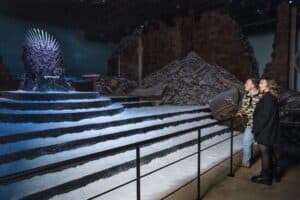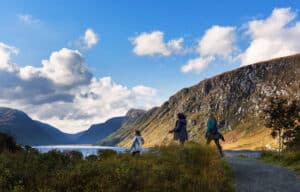Located in County Kerry, on Ireland’s South West Atlantic coast, the Dingle Peninsula boasts some of the most breathtaking scenery in all of the country. Named after the nearby town of Dingle, the peninsula is historically known as “Corca Dhuibhne”, which means seed or tribe of Duibhne. Here we’ll take a look at the top 7 things to do when visiting the Dingle Peninsula.
Dingle Bay
 Dingle Bay offers a beautiful contrast of rolling green hills wrapped in a deep blue coastline which gives visitors the opportunity to enjoy some relaxing fishing or exciting water sports. One particular mammal has become a regular fixture in the life around dingle bay, and is known to live in very close contact with humans. Fungie the dolphin was first spotted in the waters of Dingle in 1983 and has been a friendly companion to swimmers, surfers, divers and kayakers ever since. Some boat operators even go so far as to say they’ll refund your money if you don’t see him!
Dingle Bay offers a beautiful contrast of rolling green hills wrapped in a deep blue coastline which gives visitors the opportunity to enjoy some relaxing fishing or exciting water sports. One particular mammal has become a regular fixture in the life around dingle bay, and is known to live in very close contact with humans. Fungie the dolphin was first spotted in the waters of Dingle in 1983 and has been a friendly companion to swimmers, surfers, divers and kayakers ever since. Some boat operators even go so far as to say they’ll refund your money if you don’t see him!
Mount Brandon
With a peak height of 3,122ft Mount Brandon is the highest point on the Dingle Peninsula. Brandon stands in the middle of a high ridge, known as the Brandon Group, which runs for 10km along the peninsula. Hikers who reach the summit are treated to a combination of beautiful ocean views sided with rugged mountainous terrain taken straight from a fantasy novel. Due to its connection with Saint Brendan, the mountain is popular with Irish Catholic pilgrims and a pilgrimage route runs from Cill Mhic an Domhnaigh to Brandon’s summit.
Gallarus Oratory
 This stone structure is one of the most famous landmarks on the peninsula and is situated close to Gallarus Castle. Part of the allure held by Gallarus Oratory is surely down to the mystery surrounding origins and purpose. Although there is no clear evidence as to when it was built or what purpose it served, several people have hypothesized possible uses for the oratory. Most likely it served as some kind of church or chapel, but there’s also speculation that it may have been used as a shelter for pilgrims. The structure which is made primarily of stone, covers approximately 155 square feet. The methods used in the stacking of the stone give the oratory a look not unlike that of an upturned boat.
This stone structure is one of the most famous landmarks on the peninsula and is situated close to Gallarus Castle. Part of the allure held by Gallarus Oratory is surely down to the mystery surrounding origins and purpose. Although there is no clear evidence as to when it was built or what purpose it served, several people have hypothesized possible uses for the oratory. Most likely it served as some kind of church or chapel, but there’s also speculation that it may have been used as a shelter for pilgrims. The structure which is made primarily of stone, covers approximately 155 square feet. The methods used in the stacking of the stone give the oratory a look not unlike that of an upturned boat.
Kilmalkedar
This Early Christian site lies on the Western part of the peninsula and stretches for roughly 10 acres. Although the history of the site is associated with St Brendan, it is thought to have been founded by St Maolcethair, a local saint. The ruins of a 12th century Romanesque church stands at the center of the site. The 4 walls still stand and the beautiful stonework and arched doorways offer an awe-inspiring look into the past. Several other notable attractions are scattered around the site including a sundial and a stone cross, along with 2 ancient pillars inscribed with writings dating as far back as the 6th century.
Blasket Islands
 The Blasket islands are a group of uninhabited islands just off the coast of the Peninsula. Abandoned in 1954, the purely Irish speaking population were forced to the mainland to seek amenities that weren’t reaching the declining island population. Many of the former inhabitants are said to have settled on the Dingle Peninsula, within eyeshot of their former home. Today the islands offer an isolated camping experience or a relaxing days hiking for those who decide to visit. A ferry service runs from Dunquin to Great Blasket Island and back.
The Blasket islands are a group of uninhabited islands just off the coast of the Peninsula. Abandoned in 1954, the purely Irish speaking population were forced to the mainland to seek amenities that weren’t reaching the declining island population. Many of the former inhabitants are said to have settled on the Dingle Peninsula, within eyeshot of their former home. Today the islands offer an isolated camping experience or a relaxing days hiking for those who decide to visit. A ferry service runs from Dunquin to Great Blasket Island and back.
Eask Tower
Built in 1847 with a view to guiding ships and boats into the mouth of the blind harbour, this solid stone tower sits atop Caraloo Hill at the south of the peninsula. It currently stands at 40ft high and is crowned with a 19th century mariners beacon and World War II lookout post. The original build, which provided much needed employment during the Famine, was approximately 13ft shorter than it is today, the extension being added around the turn of the century. The wooden hand pointing from the tower, guides the boats to their destination.
Slea Head Drive
 One of Ireland’s most scenic routes is situated at the head of the Dingle Peninsula. Slea Head Drive is a circular route beginning and ending in Dingle which forms part of the Wild Atlantic Way. En route are several landmarks and points of interest including Ventry Beach, Pre-historic Fort and Beehive huts and The Dingle Famine Cottage. The drive takes a couple of hours but it’s highly recommended to put the day aside so you can take in all the beautiful sites on offer. During the summer months, the narrow roads of the drive tend to be quite busy so be sure to plan ahead.
One of Ireland’s most scenic routes is situated at the head of the Dingle Peninsula. Slea Head Drive is a circular route beginning and ending in Dingle which forms part of the Wild Atlantic Way. En route are several landmarks and points of interest including Ventry Beach, Pre-historic Fort and Beehive huts and The Dingle Famine Cottage. The drive takes a couple of hours but it’s highly recommended to put the day aside so you can take in all the beautiful sites on offer. During the summer months, the narrow roads of the drive tend to be quite busy so be sure to plan ahead.
This remote piece of Irish coastline is an assemblage of historical sites and scenic landscapes just begging to be explored. Our 10 Day Kilkee to Kinsale Wild Atlantic Way tour offers 2 days in Dingle giving plenty of time to explore everything the peninsula has to offer. Follow the link to find out more





